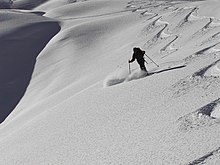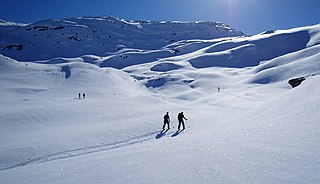
Cross-country skiing is a form of skiing whereby skiers traverse snow-covered terrain without use of ski lifts or other assistance. Cross-country skiing is widely practiced as a sport and recreational activity; however, some still use it as a means of transportation. Variants of cross-country skiing are adapted to a range of terrain which spans unimproved, sometimes mountainous terrain to groomed courses that are specifically designed for the sport.

Skiing is the use of skis to glide on snow. Variations of purpose include basic transport, a recreational activity, or a competitive winter sport. Many types of competitive skiing events are recognized by the International Olympic Committee (IOC), and the International Ski Federation (FIS).
A ski is a narrow strip of semi-rigid material worn underfoot to glide over snow. Substantially longer than they are wide, and characteristically employed in pairs, skis are attached to ski boots with ski bindings, with either a free, lockable, or partially secured heel. For climbing slopes, ski skins can be attached at the base of the ski.

Alpine skiing, or downhill skiing, is the pastime of sliding down snow-covered slopes on skis with fixed-heel bindings, unlike other types of skiing, which use skis with free-heel bindings. Whether for recreation or for sport, it is typically practiced at ski resorts, which provide such services as ski lifts, artificial snow making, snow grooming, restaurants, and ski patrol.

Snowshoes are specialized outdoor gear for walking over snow. Their large footprint spreads the user's weight out and allows them to travel largely on top of rather than through snow. Adjustable bindings attach them to appropriate winter footwear.

Skiing, or traveling over snow on skis, has a history of at least eight millennia. The earliest archaeological examples of skis were found in Karelia and date to 6000 BCE. Although skiing's origins were purely utilitarian, the modern sport evolved from beginnings in Scandinavia, starting in the mid-1800s skiing became a popular recreational activity and sport, becoming practiced in snow-covered regions worldwide, and providing a market for the development of ski resorts and their related communities.

Nordic skiing encompasses the various types of skiing in which the toe of the ski boot is fixed to the binding in a manner that allows the heel to rise off the ski, unlike alpine skiing, where the boot is attached to the ski from toe to heel. Recreational disciplines include cross-country skiing and Telemark skiing.

Telemark skiing is a skiing technique that combines elements of Alpine and Nordic skiing, using the rear foot to keep balance while pushing on the front foot to create a carving turn on downhill skis with toe-only bindings. Telemark skiing is named after the Telemark region of Norway, where the discipline originated. Sondre Norheim is often credited for first demonstrating the turn in ski races, which included cross country, slalom, and jumping, in Norway around 1868. Sondre Norheim also experimented with ski and binding design, introducing side cuts to skis and heel bindings.
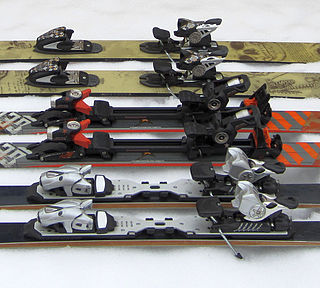
A ski binding is a device that connects a ski boot to the ski. Before the 1933 invention of ski lifts, skiers went uphill and down and cross-country on the same gear. As ski lifts became more prevalent, skis—and their bindings—became increasingly specialized, differentiated between alpine (downhill) and Nordic styles of skiing. Until the point of divergence in the mid-20th century, bindings held the toe of a flexible, leather boot against the ski and allowed the heel to rise off the ski, typically with a form of strap or cable around the heel.
Ski boots are footwear used in skiing to provide a way to attach the skier to skis using ski bindings. The ski/boot/binding combination is used to effectively transmit control inputs from the skier's legs to the snow.

Ski mountaineering is a skiing discipline that involves climbing mountains either on skis or carrying them, depending on the steepness of the ascent, and then descending on skis. There are two major categories of equipment used, free-heel Telemark skis and skis based on Alpine skis, where the heel is free for ascents, but is fixed during descent. The discipline may be practiced recreationally or as a competitive sport.
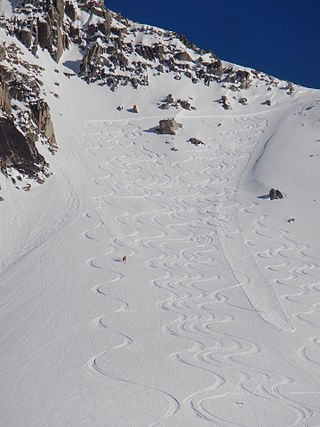
Backcountry skiing (US), also called off-piste (Europe), alpine touring, freeriding or out-of-area, is skiing in the backcountry on unmarked or unpatrolled areas either inside or outside a ski resort's boundaries. This contrasts with alpine skiing, which is typically done on groomed trails benefiting from a ski patrol. Unlike ski touring, backcountry skiing can - and often does - include the use of ski lifts including snowcats and helicopters. Recent improvements in equipment have increased the popularity of the sport. As the sport does confront the individual practicing it with the dangers of natural, unprepared alpine terrain like avalanches, it is generally recommended to carry standard safety equipment and to learn beforehand how to behave safely under such conditions.
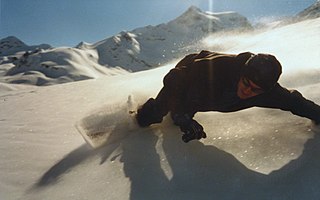
Freeriding is a style of snowboarding or skiing performed on natural, un-groomed terrain, without a set course, goals or rules. It evolved throughout the sport's formative early years as a contrary response to the highly regimented style of ski competition prevalent at the time. Snowboarders primarily refer to freeriding as backcountry, sidecountry, or off-piste snowboarding, and sometimes big mountain or extreme riding.

A splitboard is a snowboard that can be separated into two ski-like parts used with climbing skins to ascend slopes the same way alpine touring or telemark skis are. The main difference is that a splitboard will have an additional metal edge for extra grip in ski mode. Unlike normal snowboards, it will also have nose and tail clips, split hooks, and touring mounts. Similar to cross country skiing, splitboarding allows free heel movement and with skins attached to the bottom of the skis, provides uphill traction. The two halves can then be connected to form a regular snowboard for descent. Splitboarding culture often focuses on the idea of using your own power to access the backcountry usually on unmaintained trails.

Kicking Horse Mountain Resort (KHMR) is a ski resort located 6.4 kilometres (4.0 mi) west of Golden, British Columbia, Canada. It features over 120 trails across more than 3,486 acres (14.11 km2) of skiable terrain and a 1,315-metre (4,314 ft) vertical drop, currently the sixth largest of any North American ski resort. The resort, named after the nearby Kicking Horse River and Kicking Horse Pass, spans the easternmost slope of the Purcell Mountains overlooking the Rocky Mountain Trench. It is located roughly 7 kilometres (4 mi) east of Glacier National Park and 23 kilometres (14 mi) west of Yoho National Park.
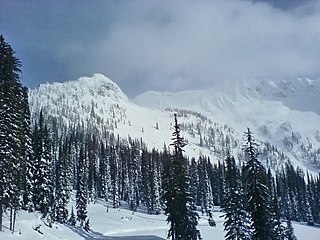
Whitewater Ski Resort is a ski resort in western Canada, located a 25-minute drive from Nelson in southern British Columbia. In the Selkirk Mountains, the resort is situated in Ymir bowl, beneath the 2,400-metre-high (7,874 ft) Ymir Mountain. The Selkirks receive plentiful, dry snow, and the location in a high alpine bowl provides an annual snowfall average of approximately 12 m.
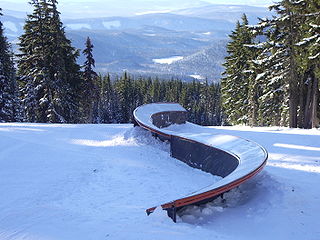
The following outline is provided as an overview of and topical guide to skiing:

Skiing in Australia takes place in the Australian Alps in the states of New South Wales, Victoria and the Australian Capital Territory as well as in the mountains of the island state Tasmania, during the Southern Hemisphere winter.

Skiing in New South Wales takes place in the high country of the Snowy Mountains of New South Wales during the Southern Hemisphere winter.
This glossary of skiing and snowboarding terms is a list of definitions of terms and jargon used in skiing, snowboarding, and related winter sports.


